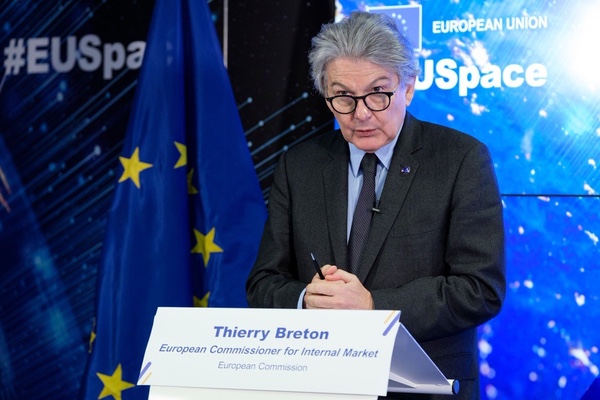Defining European space ambitionsby Jeff Foust
|
| “They all have their own ship to discover the next frontier, and that means the next economic zone, which is the Moon and beyond,” Aschbacher said of China, Russia, and the US. “Europe doesn’t have such a ship.” |
It serves as a reminder there is no single European space program. ESA is the best-known and biggest player in space in Europe, with a budget of €7.15 billion ($8.2 billion) in 2022. Its projects range from the International Space Station to science missions and technology development. The EU, though, is playing a larger role, running the Galileo satellite navigation and Copernicus series of Earth observation satellites in cooperation with ESA. There are also the various national space agencies that work with ESA and the EU, but also have their own projects.
That has created conflicts in the past, particularly between ESA and the EU. Some in ESA saw the EU’s growing interest in space as an effort to usurp ESA, including renaming an EU office responsible for Galileo as EUSPA, or the EU Agency for the Space Programme. Negotiations between ESA and the European Commission on a multi-year agreement regarding joint work on programs like Galileo and Copernicus dragged on.
Those EU-ESA relations, though, have improved in the last year. When Josef Aschbacher became director general of ESA nearly a year ago, he made it a priority to get that financial agreement with the EU finalized, and it was completed a few months later. Now he frequently appears side by side with Thierry Breton, the European Union commissioner responsible for space policy.
Both Aschbacher and Breton will participate in the space summit this month, helping tie together the two meetings into one. “The way that we are setting up the agenda is that they are interleaved, that they form one coherent package, and they depend on each other,” Aschbacher said of the summit during an ESA press conference last month. “It’s a very integrated meeting that is providing one big picture for Europe.”
That big picture, though, will have different facets. ESA plans to use the meeting to win political support for a series of new initiatives outlined in a document last November called the Matosinhos Manifesto, after the Portuguese city where ESA ministers met to approve it. That document endorsed three initiatives called “accelerators” on topics such as climate change, using space assets for rapid response to crises and space safety, leveraging current ESA capabilities as well as those that can be developed in the near term.
The manifesto also included two long-term “inspirators” for ESA to pursue. One would be a mission to go to an icy moon in the outer solar system, like Saturn’s moon Enceladus, and collect samples to return to Earth. Such a mission would be technically challenging, Aschbacher acknowledged, but could provide scientists with evidence of the habitability of such ocean worlds and even evidence of life itself.
The second inspirator would be for ESA to pursue a human space exploration program. Since taking office last year, Aschbacher has emphasized that, unlike the US, Russia, and China, Europe does not have its own ability to launch people into orbit. Even India, he noted at the press conference, is developing its own human spaceflight program with a first crewed launch as soon as next year.
“They all have their own ship to discover the next frontier, and that means the next economic zone, which is the Moon and beyond,” he said. “Europe doesn’t have such a ship.”
| “In a year’s time we will be much better placed to give you precise estimates, if we do get a mandate from our political establishment to do so,” Aschbacher said of the cost of a human spaceflight program. |
“This is quite amazing knowing that Europe has been an explorer, a pioneer in the 15th century and beyond,” he added. “This exploration has brought to Europe a very important status as a rich set of countries, a rich continent, which has been defining history for several hundred years.”
He said he hopes to secure a political endorsement, but not yet funding, for a human spaceflight program at this month’s summit. “I would certainly hope to get a very good debate by the political establishment in Europe,” he said. “Hopefully, a mandate that we have to work on this to make concrete proposals.” Those proposals would take about a year to develop, he added.
What form a human space exploration program would take isn’t clear, although ESA officials appeared to rule out one option of using Soyuz spacecraft launched from an existing pad in French Guiana. “Theoretically one could launch a crewed Soyuz vehicle from Kourou,” said David Parker, director of human and robotic space exploration at ESA, during the press conference. The problem, he said, is with the launch abort system: it is designed to bring the Soyuz spacecraft over land from the Baikonur Cosmodrome in Kazakhstan. An abort during a launch from French Guiana would bring the spacecraft down over water. “It’s theoretically possible but not very practical.”
Aschbacher said it was premature to give a cost estimate for a human spaceflight program, citing the need to do studies first. “In a year’s time we will be much better placed to give you precise estimates, if we do get a mandate from our political establishment to do so.”
ESA is already looking for ways to increase its role in the NASA-led Artemis program with the goal of getting a European astronaut on the surface of the Moon by the end of the decade. “These negotiations are ongoing. They’re quite intense, actually,” he said, adding that he hopes to have more details by the summer.
ESA is proposing to develop a large cargo lunar lander called the European Large Logistics Lander, or EL3, that could support future Artemis missions and, through a barter agreement, secure spots on those missions for European astronauts. “This is a capability that NASA is interested in, and discussions are ongoing,” Parker said.
 Thierry Breton, the European Union commissioner responsible for space policy, said at a conference last month that support for a proposed European secure connectivity constellation was a priority. (credit: European Commission) |
While ESA goes to the space summit to seek support for human spaceflight and other initiatives, the EU has its own priorities. That’s led by its desire to develop a satellite constellation that will provide broadband and secure communications for Europe. The broadband aspects of the system are intended to address “digital divide” issues in Europe, while the secure communications aspect—potentially using quantum encryption technologies—would serve European government agencies and militaries.
“It is a true geopolitical infrastructure. It will reduce European dependencies on non-European commercial initiatives under development,” Breton, the EU commissioner, said at the European Space Conference January 25 in Brussels.
Details about the proposed constellation, he said then, would be released in a few weeks; those details could come out as soon as this week ahead of the February 16 space summit. He said he envisions the system as a “multi-orbit” one, using satellites in LEO, GEO, and other orbits serving government and commercial users. “It should integrate from the start the military usage and needs. Using LEO satellites, it opens up several fields of interest,” he said.
He added that because it is a “strategic constellation,” it would be set up “to avoid any dependencies on third countries.”
| Kavvada emphasized the importance of having a European system that could offer secure communications. “It will be of paramount importance.” |
That would rule out, as some have suggested, working with OneWeb even though one of its largest shareholders is French satellite operator Eutlesat. The company is based in London with the UK government and Indian telecommunications company Bharti Global as major shareholders; its satellites are built at a Florida factory run as a joint venture with Airbus. Breton was sharply critical last year of Eutelsat’s decision to invest in OneWeb, at one point suggesting that Eutelsat had to decide whether to hold a stake in OneWeb or participate in the EU constellation.
The question came up during a panel discussion later at the conference. “I see all the eyes turning to me,” said one panelist, Ekaterini Kavvada, director for innovation and outreach at the European Commission directorate responsible for space and one of the leaders in planning of the EU constellation. She emphasized the importance of having a European system that could offer secure communications. “It will be of paramount importance, and everything will be assessed against these criteria.”
While details of the constellation have yet to be disclosed, Breton said at the conference that the system would cost €5–6 billion ($5.7–6.9 billion) to develop through a public private partnership. One third would come from the European Commission’s own budget, one third from member states’ contributions, and one third from private investors. “I’m confident that we’ll be able bring everything together.”
ESA will likely have a role in the constellations development and contribute funding, with a “working assumption” of providing about €750 million ($860 million), Aschbacher said at the press conference.
“We are working hand-in-hand with the European Commission,” said Elodie Viau, director of telecommunications at ESA, at the press conference. “We are working towards establishing the structure and the goals of this project. In our role as ESA, we are there to support the European Commission’s ambitions and innovation, and to boost the competitiveness of our European industry.”
One European satellite operator called for urgency in developing the system. “We’ve got some really good solutions,” said Steve Collar, CEO of SES. “We have everything that we need. What we now need is to move forward with purpose.”
That includes, he said, starting development of the constellation this year. “We’re well prepared. We have a very clear idea of where we need to go,” he said, calling for developing the system in phases. “This constellation is not going to achieve everything at first, so you need a series of steps. But we need to start.”
Note: we are using a new commenting system, which may require you to create a new account.
